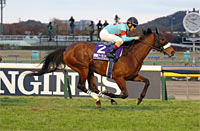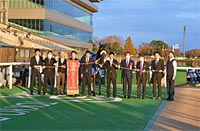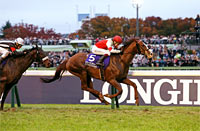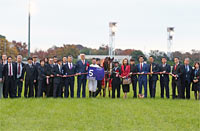Japan Cup (G1) - Data Analysis
The ultimate contest on the 2,400m turf course at Tokyo
No foreign-trained horse has won the Japan Cup since Alkaased in 2005, and none has even made into the Top 3 since Ouija Board finished 3rd in 2006. But while there is certainly a trend for Japanese-trained horses to prevail in recent years, it is always interesting to see how the overseas runners will perform in this race. And given that it offers the highest prize money in Japanese racing (alongside the Arima Kinen), it is sure to be hotly contested. So let’s check for trends in this race based on data from the last 10 years.
Highly favored horses have the edge
Looking at performances by favoritism over the last 10 years, nine of the 10 winners in that time had been backed among the “Top 5 favorites,” the exception being Screen Hero in 2008 (9th favorite). What’s more, every runner-up had started the race among the “Top 7 favorites.” By contrast, six of the ten 3rd-place finishers had been billed as “6th favorite or lower.” Turning next to performances by win odds, horses supported by odds of “2.9 or lower” have a peerless Top 3 ratio of 100%. Horses with odds of “3.0-3.9” have also performed well, but those with “4.0-4.9” have tended to struggle, producing only one runner-up between them. Finally, the only runners with odds in the 10 range to finish in the Top 3 were those with odds of “10.0-14.9”; no horse backed by odds of “15.0-19.9” has finished in the Top 3. [Table 1] [Table 2]
[Table 1] Performance by favoritism (last 10 years)
| Favoritism |
Performance
[1st-2nd-3rd-4th or lower] |
Win ratio |
Top 2 ratio |
Top 3 ratio |
| 1st favorite |
3-3-2-2 |
30.0% |
60.0% |
80.0% |
| 2nd favorite |
1-1-2-6 |
10.0% |
20.0% |
40.0% |
| 3rd favorite |
1-1-0-8 |
10.0% |
20.0% |
20.0% |
| 4th favorite |
3-1-0-6 |
30.0% |
40.0% |
40.0% |
| 5th favorite |
1-1-0-8 |
10.0% |
20.0% |
20.0% |
| 6th, 7th favorite |
0-3-3-14 |
0% |
15.0% |
30.0% |
| 8th, 9th favorite |
1-0-1-18 |
5.0% |
5.0% |
10.0% |
| 10th favorite or lower |
0-0-2-82 |
0% |
0% |
2.4% |
[Table 2] Performance by win odds (last 10 years)
| Win odds |
Performance
[1st-2nd-3rd-4th or lower] |
Win ratio |
Top 2 ratio |
Top 3 ratio |
| 2.9 or lower |
1-2-2-0 |
20.0% |
60.0% |
100% |
| 3.0-3.9 |
3-1-1-3 |
37.5% |
50.0% |
62.5% |
| 4.0-4.9 |
0-1-0-6 |
0% |
14.3% |
14.3% |
| 5.0-9.9 |
4-1-2-14 |
19.0% |
23.8% |
33.3% |
| 10.0-14.9 |
1-3-2-10 |
6.3% |
25.0% |
37.5% |
| 15.0-19.9 |
0-0-0-7 |
0% |
0% |
0% |
| 20.0-29.9 |
0-2-1-7 |
0% |
20.0% |
30.0% |
| 30 or higher |
1-0-2-97 |
1.0% |
1.0% |
3.0% |
Focus on 4-year-olds
In the performance by age over the last 10 years, all the winners have been aged 5 or less, as have nine of the 10 runners-up (the exception being the 6-year-old Pop Rock in 2007). As these statistics suggest, younger horses have enjoyed more success in this race. And although two 7-year-olds (Jaguar Mail in 2011 and Tosen Jordan in 2013) have finished 3rd despite being backed as only the 10th favorite or lower, runners aged 6 and above seem not to do so well here. [Table 3]
[Table 3] Performance by age (last 10 years)
| Age |
Performance
[1st-2nd-3rd-4th or lower] |
Win ratio |
Top 2 ratio |
Top 3 ratio |
| 3 |
2-2-2-24 |
6.7% |
13.3% |
20.0% |
| 4 |
6-3-3-41 |
11.3% |
17.0% |
22.6% |
| 5 |
2-4-3-35 |
4.5% |
13.6% |
20.5% |
| 6 |
0-1-0-24 |
0% |
4.0% |
4.0% |
| 7 |
0-0-2-12 |
0% |
0% |
14.3% |
| 8 |
0-0-0-8 |
0% |
0% |
0% |
Check performances by body weight
On checking the performances of runners over the last 10 years in terms of their body weight, those in the weight ranges “460-478kg” and “480-498kg” have been the most frequent Top 3 finishers. The only horse weighing “500kg or more” to have won this race over the last 10 years was Kitasan Black (536kg) in 2016. If we extend our scope to the last 20 occasions (except 2002, when the race was held at Nakayama Racecourse), there were three wins by horses weighing 502kg in that time – Pilsudski in 1997, Tap Dance City in 2003 and Zenno Rob Roy in 2004 – but those weighing “460-478kg” and “480-498kg” are still the more successful overall. [Table 4]
[Table 4] Performance by body weight (last 10 years)
| Body weight |
Performance
[1st-2nd-3rd-4th or lower] |
Win ratio |
Top 2 ratio |
Top 3 ratio |
| 458kg or less |
1-2-0-21 |
4.2% |
12.5% |
12.5% |
| 460-478kg |
4-2-1-25 |
12.5% |
18.8% |
21.9% |
| 480-498kg |
4-3-5-53 |
6.2% |
10.8% |
18.5% |
| 500-518kg |
0-3-4-31 |
0% |
7.9% |
18.4% |
| 520kg or more |
1-0-0-14 |
6.7% |
6.7% |
6.7% |
Find the previous race contested by JRA horses
If we aggregate performances by runners over the last 10 years (JRA horses only) in terms of their previous outing, we find that 19 of the 30 Top 3 finishers had most recently contested the Tenno Sho (Autumn). So we should keep a particularly keen eye on runners coming from that race. Other strong performers in the Japan Cup had most recently been seen in graded races at Kyoto Racecourse – the Kyoto Daishoten, Shuka Sho and Kikuka Sho (Japanese St. Leger) – as well as the Copa Republica Argentina and the Prix de l’Arc de Triomphe. [Table 5]
[Table 5] Performance by previous race of JRA horses (last 10 years)
| Previous race |
Performance
[1st-2nd-3rd-4th or lower] |
Win ratio |
Top 2 ratio |
Top 3 ratio |
| Tenno Sho (Autumn) |
6-6-7-42 |
9.8% |
19.7% |
31.1% |
| Shuka Sho |
1-0-1-3 |
20.0% |
20.0% |
40.0% |
| Kikuka Sho |
1-0-0-9 |
10.0% |
10.0% |
10.0% |
| Prix de l’Arc de Triomphe |
0-2-1-3 |
0% |
33.3% |
50.0% |
| Other G1 (including overseas) |
0-1-0-6 |
0% |
14.3% |
14.3% |
| Kyoto Daishoten |
1-1-0-11 |
7.7% |
15.4% |
15.4% |
| Copa Republica Argentina |
1-0-1-11 |
7.7% |
7.7% |
15.4% |
| Other races |
0-0-0-14 |
0% |
0% |
0% |
Look for a “4th” in recent races
Over the last 10 years, the Japan Cup has been noted for Top 2 finishes by horses that “Finished 4th in a graded race within the previous two outings,” and this trend has become particularly conspicuous in recent years. In fact, there has been one runner fitting this in each of the last four years since 2013. If any of this year’s runners comes with this kind of record, it might well be worth a punt. [Table 6]
[Table 6] Top 2 finishers with a 4th place finish in a graded race within the previous two outings (last 10 years)
| Year |
Finish |
Horse |
Race in question |
| 2007 |
2nd |
Pop Rock |
Last race |
Tenno Sho (Autumn) |
4th |
| 2009 |
2nd |
Oken Bruce Lee |
Last race |
Tenno Sho (Autumn) |
4th |
| 2011 |
1st |
Buena Vista |
Last race |
Tenno Sho (Autumn) |
4th |
| 2013 |
2nd |
Denim and Ruby |
2 races back |
Shuka Sho |
4th |
| 2014 |
1st |
Epiphaneia |
2 races back |
Audemars Piguet Queen Elizabeth II Cup |
4th |
| 2015 |
1st |
Shonan Pandora |
Last race |
Tenno Sho (Autumn) |
4th |
| 2016 |
2nd |
Sounds of Earth |
Last race |
Kyoto Daishoten |
4th |
Seek out the winner!
Finishing “3rd in a graded race at Hanshin” is a key point for winners
In each of the last 4 years, the Japan Cup has been won by a horse that “Finished 3rd in a graded race in the spring season.” What’s more, each of those races has been held at Hanshin Racecourse. If any of this year’s runners meets this kind of condition, we would be advised to take a closer look. [Table 7]
[Table 7] Graded race in which the last 4 winners finished “3rd” in the spring
| Year |
Winning horse |
Graded race with 3rd place finish |
| 2013 |
Gentildonna |
2 races back |
Takarazuka Kinen |
3rd |
| 2014 |
Epiphaneia |
3 races back |
Sankei Osaka Hai |
3rd |
| 2015 |
Shonan Pandora |
3 races back |
Takarazuka Kinen |
3rd |
| 2016 |
Kitasan Black |
2 races back |
Takarazuka Kinen |
3rd |
(Yasunori Asano) |




















